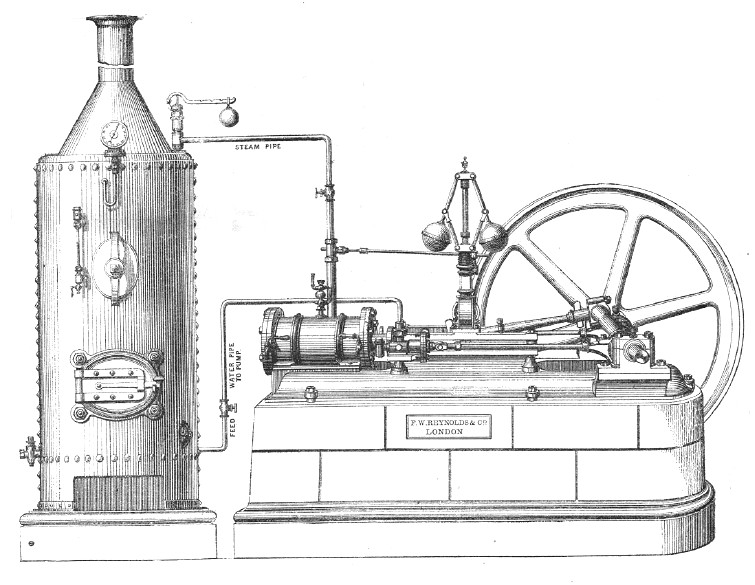Manufacturers Index - F. W. Reynolds & Co.
F. W. Reynolds & Co.
London, England, U.K.
Manufacturer Class:
Wood Working Machinery & Steam and Gas Engines
Last Modified: May 25 2022 10:20PM by Jeff_Joslin
If you have information to add to this entry, please
contact the Site Historian.
|
F. W. Reynolds & Co. was established in in 1868. They were located at Southwark Street in London. They manufactured steam engines plus combined circular and band saws or sawing machines; saw benches; morticing, boring, and tenoning machines; and drilling machines.
 |
| Horizontal high-pressure steam engine with vertical boiler. From 1876 F. W. Reynolds Illustrated Catalogue of Builders' Machinery & Appliances |
Information Sources
- Farmer’s Magazine Jul 1875 pgs 34-39
- An 1878-12-14 The Building World advertisement shows their Monarch patent mortiser. The ad quotes the 1874-12-26 issue of The Building News: "Messrs. F. W. Reynnolds and Co., of Southwark Street, have just introduced a new mortising machine, which they call the 'Monarch,' combining the most recent improvements...". The counterweight in the drawing reads, "PATENT No 3234 / TRADEMARK / FWR&Co". That patent corresponds to the retroactively renumbered patent GB-187,403,234.
- 1881 Journal of the Bath and West of England Society, Vol. XIII, in a "Report on the Implements exhibited at the Tunbridge Wells Meeting of the Bath and West of England Society and Southern Counties Association, 1881", page 10.
Three adjacent stands in the Machinery-in-motion Section seemed to form one large carpenter's shop. They were occupied respectively by Messrs. W. Olley and Co. ...; Messrs. Charles Powis and Co. ...; and Messrs F. W. Reynolds and Co., of 73, Southwark Street, London, and were devoted to the display of saw-benches, mortising machines, and all kinds of carpentering and joining appliances. Along the back of each stand ran a long shaft, from which a row of belts operated the various machinery at work. ... Messrs. Reynolds exhibited an 8-horse-power improved Contractor's portable engine with patent feed-water heater and patent tube-cleaner, their "Combination" circular and band saw-bench, their "Imperial,", "Princess," and "Comet," band-saw machines, and various other appliances for mortising, boring, drilling, core-driving, planing, moulding, &c.
- 1883-08-01 The British Trade Journal, in an article on "The New Zealand Exhibition" (pp. 473-474).
Messrs. F. W. Reynolds & Co., of the Acorn Works, Blackfriars Road, London, have a very useful collection of wood-working machinery, which it seems a pity was not accompanied by a skilled mechanic and shown at work. In the collection is the new patent "Comet" hand-power band-saw, capable of being fitted for power. It appears a very light and compact machine, and from its loose pulley, brass saw-guide, and simple tension arrangement, should command the attention of cabinetmakers. A very useful circular-saw bench seems to be appropriately named, the "Contractor's." It is light and serviceable, and is, moreover, fitted with a very simple and novel adjustable fence. The machine known as the "Imperial Combination," uniting the band-saw and circular-saw on one framing, has much to recommend it in economy of space and first cost. Fitted for hand or steam power, with band-saw table, capable of being canted to any angle, with rising and falling spindle, and a very simple yet effective and patented method of regulating the tension of the saw, it seems almost the perfection of machinery. A new kind of feeding-gear, worked by cog-wheels, grips the log on the top, biting in the line of the circular saw, so that it is not possible to injure the finest plane-up work. Other saw-bench and mortising and tenoning machines complete this representative exhibit. The "Eclipse" new patent mortising machine, is, however, deserving of a brief description, as it appears to be a novelty in these useful tools. In place of the usual rack and cog-wheel, it has an articulated elbow-movement, which gives the necessary vertical motion, and increased power to the chisel, as it enters deeper and deeper into the material. The lever is always brought down to the lowest point, but the regulating of the depth of mortices not required to pass through the wood is effected by making the part adjustable which carries the chisel-spindle of the fulcrum of the lever.
|